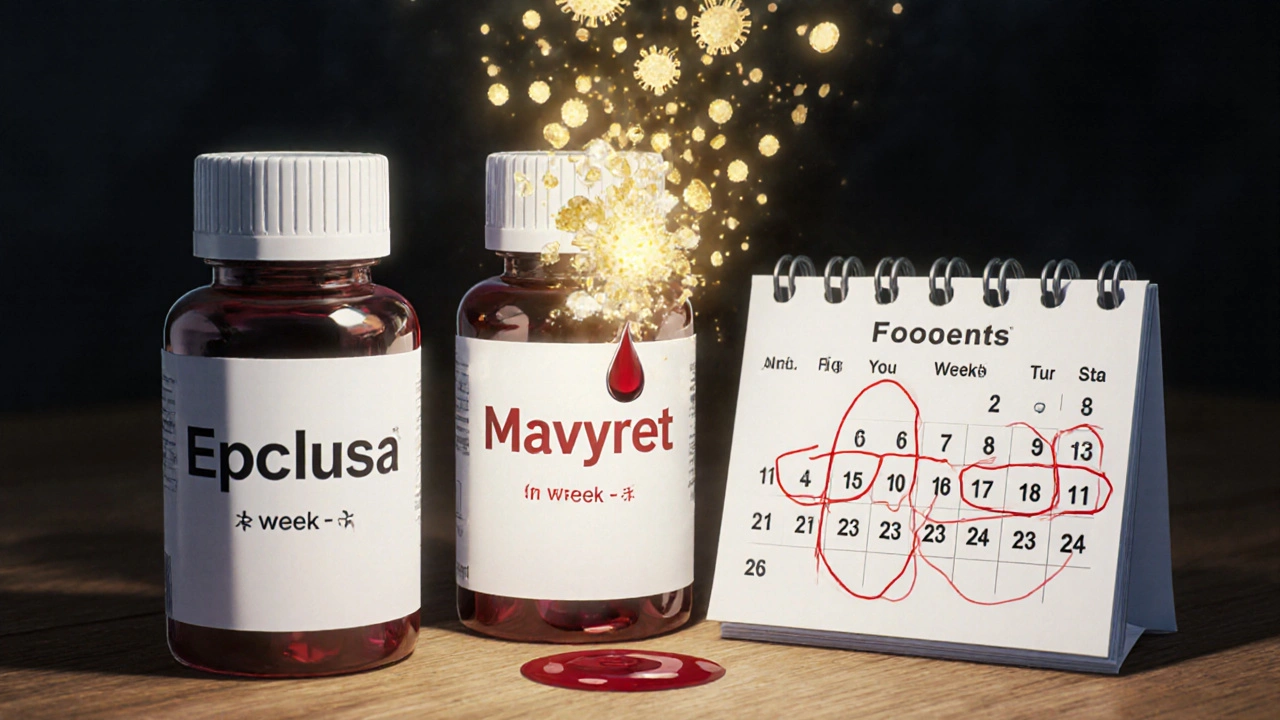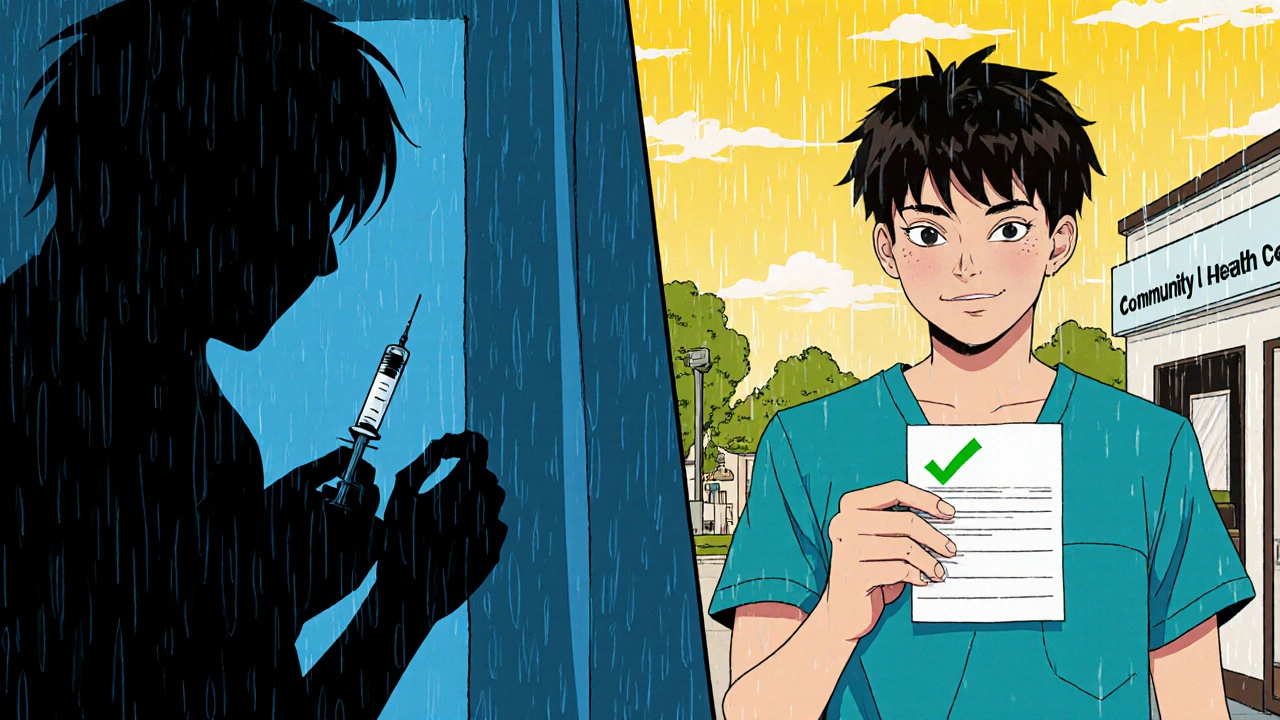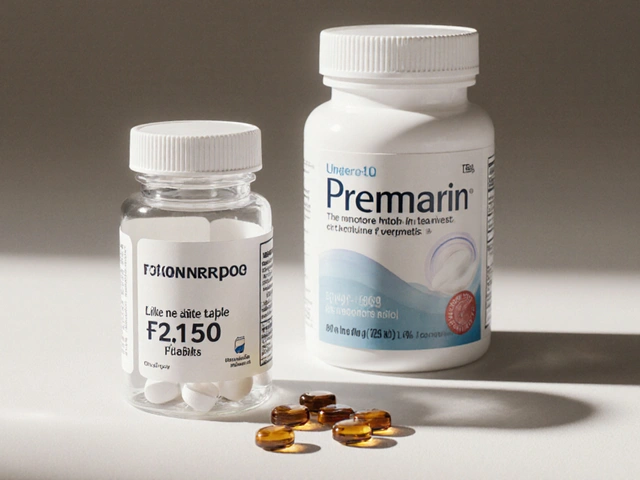
Health November 19, 2025
Hepatitis C Cure Rates With Direct-Acting Antivirals: What You Need to Know
More than 95 out of every 100 people treated with modern hepatitis C drugs are cured. That’s not a guess. It’s what happens in real clinics, in real lives, across the world. Since 2013, when the first direct-acting antivirals (DAAs) hit the market, hepatitis C has gone from a slow, damaging illness with brutal side effects to a simple, 8-to-12-week pill regimen that clears the virus in nearly everyone who takes it. Yet, despite this breakthrough, millions still don’t get treated. Why? It’s not because the drugs don’t work. It’s because access, cost, and awareness still stand in the way.
How DAAs Changed Everything
Before DAAs, hepatitis C treatment meant weekly injections of interferon, often paired with ribavirin. People endured months of fatigue, depression, nausea, and anemia. Even then, only about half the patients cleared the virus. Many quit because the side effects were worse than the disease. Then came DAAs. These pills target specific parts of the hepatitis C virus-its enzymes, its replication machinery-so the virus can’t multiply. No immune system stimulation. No injections. Just one or two pills a day for as little as eight weeks. The results? Cure rates above 95% across all major strains of the virus, even in people with cirrhosis or HIV co-infection. Studies from the U.S., Europe, and Australia confirm this. One nationwide analysis of over 6,600 insured patients found 97.3% achieved sustained virologic response (SVR)-the medical term for being cured. Another study of 238 patients showed 92.8% were virus-free 12 weeks after finishing treatment. These aren’t lab numbers. These are real people walking out of clinics with a clean bill of health.Which Drugs Work Best?
Today, there are several pangenotypic DAA regimens-meaning they work against all major HCV genotypes without needing complex testing first. The most common include:- Sofosbuvir-velpatasvir (Epclusa)
- Glecaprevir-pibrentasvir (Mavyret)
- Sofosbuvir-velpatasvir-voxilaprevir (Vosevi)
Who Gets Left Behind?
Here’s the hard truth: even with 95%+ cure rates, most people with hepatitis C still aren’t getting treated. In the U.S., less than one in three people with health insurance start treatment within a year of diagnosis. For Medicaid patients, it’s worse-only 23% get the drugs they need. Why? A mix of red tape, provider hesitation, and stigma. Some doctors still think hepatitis C is only for people who use drugs or have a history of blood transfusions. But today, many cases are found in older adults who were infected decades ago, before screening was routine. The biggest gap? People with decompensated cirrhosis or liver cancer. Studies show they’re 30% less likely to get DAAs-even though curing HCV in these patients can improve liver function and prevent death. The drugs work. But the system often doesn’t.
Cost: The Hidden Barrier
When DAAs first launched in 2013, a 12-week course cost about $84,000 in the U.S. That price tag caused global outrage. But things have changed. Generic versions are now available in many countries. In low- and middle-income nations, a full course can cost as little as $260. In places like Egypt and India, national programs have brought treatment to millions. But in the U.S., prices haven’t dropped enough for many. Insurance companies still require prior authorizations, proof of liver damage, or sobriety before approving treatment. That delays care. And delay means more liver scarring, more risk of cancer, more deaths.What About Long-Term Results?
Curing hepatitis C isn’t just about clearing the virus. It’s about saving lives. People who achieve SVR see lower rates of liver cancer, fewer hospital stays, and better survival. One study found that treated patients had a 45% lower risk of dying from liver disease compared to those who never got treated. There are also benefits beyond the liver. People cured of HCV have lower rates of kidney disease, diabetes complications, and even certain types of lymphoma. The virus doesn’t just attack the liver-it messes with your whole body.
Why Aren’t We Winning Yet?
The World Health Organization set a goal: eliminate hepatitis C as a public health threat by 2030. That means 90% fewer new infections and 80% fewer deaths. We have the tools. We have the science. But we don’t have the will. Only 68% of countries reimburse DAAs. In 61% of those countries, only specialists can prescribe them-keeping treatment out of reach for primary care doctors and community clinics. The pandemic made it worse. Screening dropped. Appointments were canceled. People disappeared from the system. And yet, progress is possible. In Scotland, a national screening and treatment program cut new infections by 80% in five years. In Australia, a government-funded drug program brought cure rates above 90% across all demographics.What Should You Do?
If you’ve ever had a blood transfusion before 1992, used injection drugs, gotten a tattoo in an unregulated setting, or were born between 1945 and 1965-you should get tested. One simple blood test can find hepatitis C. If it’s positive, a second test confirms if the virus is still active. If you’re diagnosed, don’t wait. DAAs are safe, effective, and often covered by insurance. Ask your doctor for a referral. If they say you need a specialist, push back. Many clinics now treat HCV without one. If you’re uninsured or underinsured, look for free clinics, community health centers, or patient assistance programs. Some pharmaceutical companies offer free or low-cost DAAs to those who qualify. Hepatitis C is no longer a life sentence. It’s a solvable problem. But only if you know you have it-and if you get treated before it’s too late.Can hepatitis C come back after being cured with DAAs?
Once you achieve sustained virologic response (SVR)-meaning the virus is undetectable 12 weeks after finishing treatment-it’s considered cured. The chance of the virus returning on its own is less than 1%. But you can get reinfected if you’re exposed again, like through sharing needles or unsterile medical equipment. That’s why prevention matters even after cure.
Do DAAs work for people with HIV or cirrhosis?
Yes. Studies show that people with HIV and hepatitis C co-infection have cure rates just as high as those without HIV-often above 95%. The same is true for people with cirrhosis. While cure rates drop slightly in advanced cases (around 87%), they’re still far better than any previous treatment. Treating HCV in cirrhotic patients can even reverse some liver damage and reduce the risk of liver cancer.
How long does DAA treatment take?
Most DAA regimens last 8 to 12 weeks. Some people with simple infections and no liver damage can finish in just 8 weeks. Those with cirrhosis or who’ve failed prior treatment may need 12 weeks. There’s no need for injections or weekly blood tests during treatment-just one pill a day.
Are there side effects with DAAs?
Very few. Most people feel completely normal during treatment. The most common side effects are mild: headache or fatigue. Unlike interferon, DAAs don’t cause depression, severe anemia, or flu-like symptoms. Serious side effects are rare. If you have advanced liver disease, your doctor will monitor you closely, but the drugs themselves are very safe.
Why are cure rates lower in some regions?
It’s not because the drugs don’t work. It’s because of access. In low-income countries, many don’t have generic versions available or can’t afford them. Even in wealthy nations, insurance rules, lack of screening, and stigma keep people from getting tested or treated. In the U.S., Medicaid patients are far less likely to get treatment than those with private insurance. The problem isn’t science-it’s systems.
Write a comment
Items marked with * are required.






13 Comments
Dana Dolan November 20, 2025 AT 01:54
Just got tested last month-turns out I had HCV since the 90s. Didn’t even know. My doctor was like, 'Oh, you’re in the baby boomer group,' and I was like, 'Wait, what?' Now I’m on Epclusa. No side effects. I’m just sitting here drinking coffee and wondering why I waited 20 years. 🤦♀️
Steve and Charlie Maidment November 21, 2025 AT 22:20
Look, I get it, the drugs work-but why are we acting like this is some kind of miracle when the real problem is that we let people get infected in the first place? I mean, we had needle exchanges, we had education, we had funding-and still, people are getting diagnosed with cirrhosis because no one cared until it was too late. It’s not a cure problem, it’s a society problem. And we’re still not fixing it.
Andrew Montandon November 22, 2025 AT 11:30
Hey everyone-just wanted to add a quick note: if you’re worried about cost, check out the Patient Access Network Foundation (PAN) and the HealthWell Foundation-they help cover copays for DAAs. Also, Mavyret and Epclusa generics are now available through some mail-order pharmacies for under $300. Don’t let insurance bureaucracy stop you. Your liver doesn’t care about prior auth forms.
Marjorie Antoniou November 23, 2025 AT 00:27
I work in a community clinic, and I’ve seen people cry when they find out they can be cured. Not because they’re happy about the pills-but because they finally feel like they’re not broken. The system fails them every day, but this? This is hope. And we need to make sure everyone gets it.
Andrew Baggley November 23, 2025 AT 03:06
95% cure rate? That’s insane. I used to think HCV was a death sentence, like AIDS in the 80s. Now it’s literally a pill you take while scrolling TikTok. I’m telling my whole family to get tested. My uncle was diagnosed last year-he’s now virus-free. No injections. No hospital stays. Just… done. We need to stop treating this like a moral failure and start treating it like a medical one.
Codie Wagers November 23, 2025 AT 20:34
Let’s be honest: the only reason cure rates are so high is because we’re cherry-picking the patients who can afford it. The real story isn’t in the clinical trials-it’s in the ERs where people show up with ascites because they couldn’t get a prescription. The science is flawless. The system? A dumpster fire. And no, ‘awareness’ won’t fix it. Money will.
James Ó Nuanáin November 24, 2025 AT 15:03
As a British citizen, I must point out that the NHS has been treating HCV with generics since 2017-with over 90% success. We didn’t wait for insurance approvals. We didn’t require sobriety tests. We simply said: ‘This is a public health crisis.’ And we fixed it. America, you have the resources. You have the technology. What you lack is the collective will to act. Shameful.
Nick Lesieur November 25, 2025 AT 12:50
So... we spent 30 years calling this a 'drug user disease' and now we're acting like it's just a bad cold? 🤡 The same people who blocked funding for harm reduction now want to pat themselves on the back for curing it? Nah. The cure didn't fix the stigma. It just made it quieter.
Angela Gutschwager November 26, 2025 AT 05:32
My mom got cured last year. No drama. No side effects. Just pills. She’s 72. She’s alive. That’s all that matters.
Dion Hetemi November 27, 2025 AT 04:23
Let’s crunch the numbers: 97% cure rate sounds great until you realize that 3% of 3 million infected Americans is 90,000 people who still die from liver cancer because they didn’t get treated. And 90% of those 90k are uninsured or on Medicaid. So yeah, the drugs work. But the system is designed to let them die quietly. That’s not a medical failure. That’s policy murder.
Kara Binning November 27, 2025 AT 22:35
I can’t believe we’re still having this conversation. We had a cure in 2013. We had the money. We had the science. But instead, we let Big Pharma hold it hostage for a decade. And now we act like it’s a miracle that people are finally getting treated? No. It’s a scandal. And we’re all complicit.
river weiss November 27, 2025 AT 23:51
For those seeking treatment: if your provider says you need a hepatologist, ask if they’ve reviewed the AASLD/IDSA guidelines. Per current standards, primary care providers are fully qualified to manage uncomplicated HCV cases. Many community health centers now offer full DAA programs without referral. You do not need to jump through hoops to get cured.
seamus moginie November 29, 2025 AT 00:21
I was diagnosed in 2020. Told I’d need a specialist. Took me six months to get an appointment. Then they told me I had to be sober for 6 months. I said, 'I’ve been sober for 12 years.' They said, 'Still need proof.' I finally got the pills through a nonprofit. Now I’m cured. And I’m still mad. This shouldn’t be this hard.